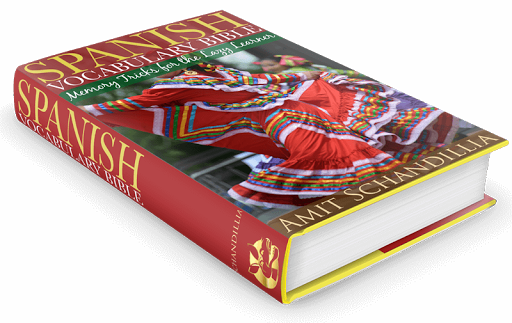Don’t get me wrong. It’s not that rote memorization doesn’t work at all. It does and has for all of us who have ever learned and mastered a second language. The problem is it’s too demanding to be practically viable in the long run. When you repeat a word-meaning pair a few million times, you forcefully condition your brain to map two completely unrelated (sound-wise) terms in a way that the mention of one instantly brings out the other. That’s how you recall stuff. But at what cost? You’re not making any real connection between the words this way and that’s why you still fumble to recall them most of the times during a live conversation. And that’s why the foreign word learned this way forever remains foreign to you because you haven’t “familiarized” yourself to it the way you’re familiar with its English counterpart. It will never become natural in your mind. So, while you can speak both English and Spanish, you can “think” only in English. The result? You’re fluent in English and not in Spanish.
Don’t have dictionaries for breakfast
 |
| Cramming up these tomes is an surefire recipe for failure Photo credit: Eliazar Parra Cardenas licensed CC BY 2.0 |
Make history work for you
So, now we know how many words to learn and which ones to learn. What remains now is the reason we’re all on this site: How to have them down. There are two major tricks up our sleeves. One is etymology or, in other words, word history. Yes, we’ve all had our “meh” moments with etymology as kids but that’s because it wasn’t relevant back then. It didn’t have any practical purpose in our lives. Now it does, and we’ll see how. Rote memorization takes an impractical amount of efforts simply because the link between the foreign word and its English counterpart is not established in that method – it’s simply forced upon our brains. Etymology is one way to address this issue. Since both Spanish and English (to a large extent) share a common Latin heritage, the field is set for etymology. Any two words, okay most of them leastwise, that share a common past can be bridged together using etymology. Take, for example, pared. That’s Spanish for wall. The two words look as related as a spider and a cellphone. Let’s see how we can use a bit of history to build a bridge between the two. Pared descends from Latin pariete. And pariete comes from an ancient Proto-Indo-European root that gives us sparri of Old Icelandic and sparro of Old High German. All these words translate into wall and still don’t sound any more familiar than pared. Not yet. But like several old Germanic words, sparro also happened to enter English as the verb support. Now that sounds familiar, doesn’t it? And it’s completely reasonable because a wall does offer support to the structure, right? So, now you can think of pared as the thing that supports other things and that’ll lead you to wall. Pared does kind of sound like the second half of support, after all. Doesn’t sound so alien anymore, does it? That’s how etymology works.
Link ’n’ learn
But etymology isn’t a universal panacea. In many cases, words have evolved so badly that they have little left in common with what they began as. Those are times you can build your own bridges. That’s where your personal creativity and imagination kicks in. Let’s call this “word-association.” Words don’t have to be authentically related in form in order for us to link them up. To give you an example, take pato. That’s Spanish for duck. Etymology is not very useful here because pato has Arabic origins and English never had anything to do with that language. So let’s connect the two words in our imagination. Picture a gang of noisy ducks duck-footing about on your patio. Or, to make it even wackier (the wackier the image, the better it sticks to memory), imagine having tea with Scrooge McDuck in your patio. Trust me, it won’t be an easy one to forget. Now, pato will always remind you of patio which will lead you to the stingy duck you were enjoying the high-tea with out there. That’s the power of imagination. How many repetitions would it have taken you to memorize that one?
Repeat after me
If you must rely on repetitions, make sure you use it as a supplement and not the sole learning technique. Repetitions are good for reviews, not for learning. And the best way to do those reviews is to follow a scientifically proven pattern. Subsequent reviews should be spaced out in the way that maximizes retention costing the least amount of efforts. That’s where automated “spaced repetition systems” (in layman terms, flashcards) come in. In this time and age where everything from eating to taking a dump (okay this one might be a stretch) is going digital, there are quite a few apps available that can take care of the spacing for us. We can call them digital flashcards. If blackjack and poker can go digital, why can’t flashcards? Luckily for us, most of them are free and open source. The two biggest names in this area are Memrise® and Anki®, the latter being easily the more popular of the two. So, the strategy is simple – identify the 2,000 words of core Spanish vocabulary, add them to an Anki® deck, and review them as the app dictates. And before you do that, familiarize yourself with each of those 2,000 words using either of the two methods discussed above. Life is just that simple, really.
The big red book of vocabulary-wizardry
 |
| Rote memorization can never be fun, nor effective |



.png)